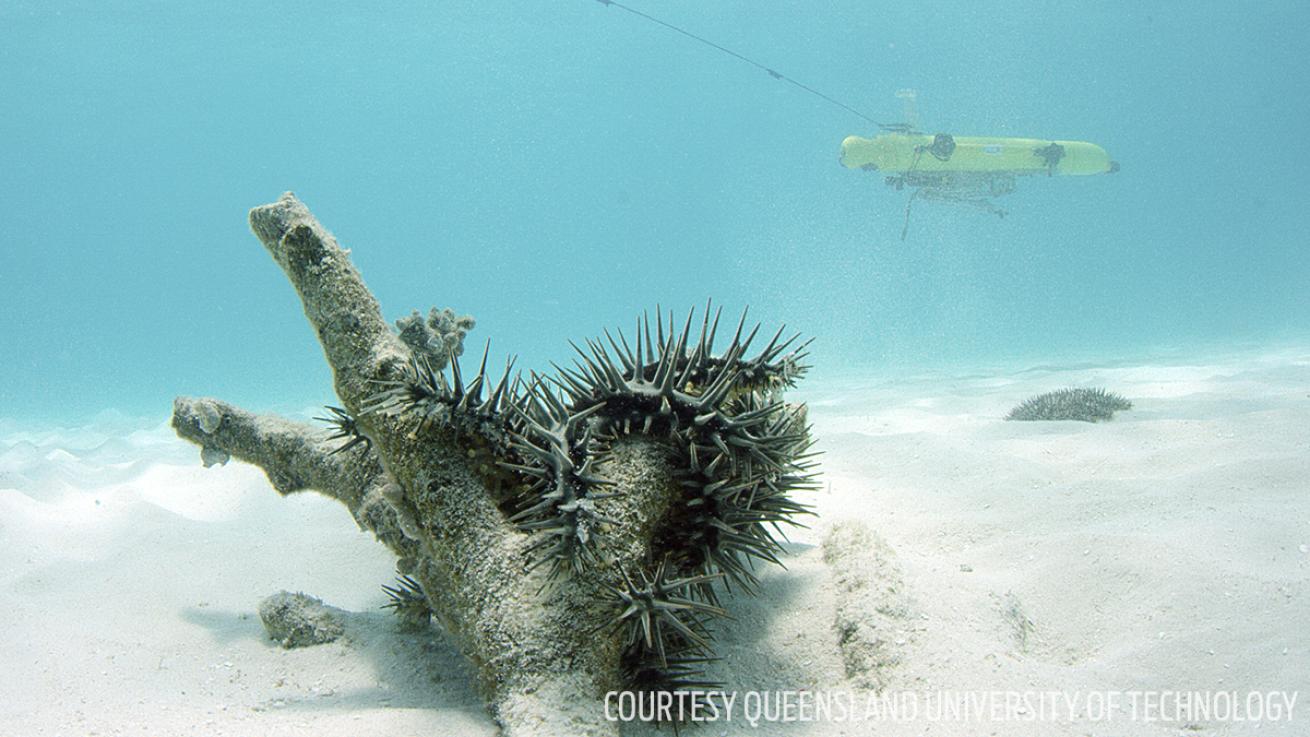Killer Underwater Drone Takes on Crown-of-Thorns Starfish
How to combat the zombielike invasion of crown-of-thorns starfish, an immediate threat to the GBR, and a potential danger to almost all coral reefs on earth?

William DukeThe crown-of-thorns starfish is an immediate threat to the Great Barrier Reef.
For years, custodians of Australia’s Great Barrier Reef have been fighting — and largely losing — a war against an alienlike invader, the crown-of-thorns starfish. But the tide might be set to turn with the introduction of the COTSbot, an autonomous underwater drone that can seek and destroy individual starfish. The GBR is a collection of almost 2,000 separate reefs spread over an area the size of Arizona. Since the 1960s, it has suffered multiple episodes when COTS populations have exploded to plague proportions. The sheer size of the GBR, the rate at which COTS can multiply, how difficult they are to kill — and the fact that they are dangerous to handle — make them a pernicious enemy to overcome. So marine scientists in Queensland are looking at robotics.

Courtesy Queensland University of TechnologyA crown-of-thorns starfish hard at work.
The COTSbot travels underwater about 3 feet above the coral, scanning for COTS. It has five independent thrusters to stabilize itself and a camera; its onboard image-processing capability allows it to recognize COTS with greater than 99 percent accuracy. Using its robotic arm, it administers a lethal injection. How does the robot know what’s a COTS and what’s not? By watching YouTube videos.
“It’s now so good, it even ignores our 3-D-printed decoys and targets only live starfish,” says Matthew Dunbabin, the robot’s inventor and principal research fellow at the Institute for Future Environments at Queensland University of Technology.
The prototype has completed ocean trials that confirm its ability to operate autonomously. The project got a boost last year when it won the people’s choice vote in the Google Impact Challenge Australia, which carried a prize of $750,000 AUS.
HOW BAD IS IT?
GBR is already under threat from the impacts of climate change and reduced water quality. But the Australian Institute of Marine Science estimates that the biggest impact is from COTS, responsible for destroying more than 40 percent of the reef over the past couple of decades. Each night, a COTS eats its own body area of coral, which adds up to 117 square feet of reef per COTS per year. With an estimated 4 million to 12 million COTS out there, the impact is colossal.

Courtesy Queensland University of TechnologyQueensland University of Technology researchers survey the bot
DIFFICULT TO CONTROL
Like many invertebrates (including corals) COTS release sperm and eggs simultaneously to increase the chance of successful proliferation. Now that there are so many more COTS, and COTS in aggregations, they have a massively improved success rate compared with relatively isolated individuals. The more COTS there are, the more successfully they multiply. A main known predator the triton sea snail, has had its own populations reduced by pollution, collection and habitat destruction.
Researchers at James Cook University in Townsville, Queensland, have discovered that 20 ml of injected vinegar has a 100 percent kill rate, a low-cost, simple solution.
On the GBR, the Association of Marine Park Tourism Operators deploys two vessels, manned by teams of divers that take out up to 400,000 COTS per annum, but still they are only just holding the status quo. It is hoped that a small fleet of COTSbots can soon be deployed to help turn the tide.

Courtesy Queensland University of TechnologyBeautiful but deadly, Acanthaster Planci might just be the scariest animal on the reef.
FACTS ABOUT THE CROWN-OF-THORNS STARFISH
• Uses its tube feet to expel its stomach, spreading the organ over coral, and then secretes enzymes that liquefy the living coral animal
• 3+ FEET IN DIAMETER — Size an adult COTS can attain (compared with 9 inches for the average sea star)
• Delivers a toxic sting with sharp, venomous 2-inch spines that cover its body
• 23 ARMS: Possible number of appendages for a large adult (five-arm sea stars are most common)
• Has been documented in outbreaks in every ocean except the Atlantic — so far can survive without feeding for up to nine months
• 65 MILLION: Number of eggs a mature female can produce per season
• Able to grow an entirely new sea star from a detached arm
• 6 MONTHS: Time it takes a COTS to regrow an arm shed due to stress or injury
• Has tube legs with thousands of suckers that help it stick to reefs — making it hard to detach
• Can undergo unexplained population booms when its numbers increase tenfold from normal population size
For more information about this project, go to QUT.EDU.AU.










